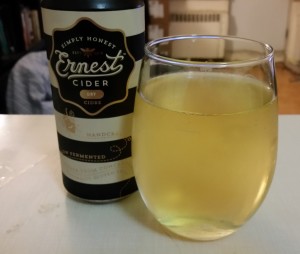The Background
Sometimes, it takes a while to write about things that people send me. It seems that as you get to the portion of a beer writing career where books enter the equation that you spend a lot less time actually writing and a lot more time arranging travel and putting things into spreadsheets. While I appreciate the utility of a spreadsheet from an organizational standpoint, they are a lot less fun than going out and drinking things. You want to talk to brewers and drink their beer, not render them as data points.
It has taken me a couple of months to get to Ernest Cider. The PR company sent it in a nice presentation box and I made notes on it, swearing that I was going to get to it at some point and after that I’m not sure quite what happened. I eventually purchased a fresh can to retaste and I’m not sure what happened after that either. I have two sets of notes for it, but never quite got around to reviewing it.
Two months apart, the notes are pretty consistent, which is a nod in their favour
The Cider
Ernest Cider is one of the newest cider companies in the province of Ontario. Their eponymous core brand features a honey bee striped can with a sort of top down entomologist’s silhouette of a honey bee as the logo. At $3.25 per 473ml can, it nestles gently at the top end price point for canned Ontario cider along with Shiny and just above Spirit Tree. At 6.4% alcohol, it’s quite strong for a typical cider.
The choice that differentiates Ernest Cider from the market is the fact that it is sweetened with honey and organic cane sugar. The cider itself is actually the product of a blend of seven apples. I quite like the fact that the website lists the suppliers of both the apples (Twin Pines Orchards) and the honey (Martin’s Sweet Farm). Honey and apple is not a new thing when it comes to beverages. Usually the combination is referred to as a Cyser. Looking at the packaging, I thought the inclusion of cane sugar was interesting so I called up the manufacturer.
It was intended to be a lobbed softball of a question: “Why did you choose to include cane sugar?” I was really only interested in knowing how that decision came to be. The result of the conversation was somewhat frustrating. The cider maker claimed that they were the only ones in Ontario backsweetening with organic cane sugar and that all cider is backsweetened and that everyone else in the province was backsweetening with sucrose.
Now, I have read enough about cider and written enough about cider to know that was not the case. The idea with backsweetening is that you’re stopping fermentation and adding sugar to alter the flavour profile of the beverage if it is too tart or dry. If you want to backsweeten without stopping fermentation, you need unfermentable sugar. Several phone calls worth of due diligence later, I can tell you that people backsweeten with all manner of things in Ontario. Yes, table sugar, but also fresh juice, molasses, unfermentable sugars, etc. Some Ontario ciders are not backsweetened at all. Those are the very, very tart ones.
The conversation managed to turn “hey, that’s kind of neat” into “you’re wrong and I know it, but now I have to do research to prove it” in a very short space of time. A good rule of thumb when asked about your product is to talk about your product and not about other people’s products.
The cider itself largely does what it says on the tin. My feeling is that it has taken a somewhat circuitous route to end up in a familiar place. The aroma is largely that of a rising ball of dry active yeast dough cut through by a hint of beeswax and an indistinct apple character. By the time you’re dealing with seven varietals, it is understandably difficult for each to remain distinct. In the second set of notes, the aroma seems to have been of reminiscent of that childhood favorite: the Peanut Butter and Honey sandwich. On the palate, the aspect is neutral and ever so slightly waxy. The cane sugar, which is there in theory to perk it up a little and add brightness, renders it fairly neutrally sweet. The apple character comes through as mealy late season cellared hand fruit with a small uptick of bright acidity at the swallow.
The Arbitrarily Chosen Score Based on Various Criteria
Today we’re going to be using the Clarkson–McManus Scale of Directional Acceleration, which runs on a scale of +5 to -5. Clearly, a +5, for the purpose of beverage reviews is a tipple that fires on all cylinders and is prepared to set lap times at Silverstone. A -5 is a disastrous misfire that is going to immediately accelerate backwards through the wall of the garage into the rumpus room.
On this scale, I’m going to give Ernest Cider a +1. The difficulty here is that it is slightly overengineered. While it has a number of features, the end result barely shifts out of neutral. Yes it has honey, but the honey takes away from the apples and makes it waxy. Yes it has organic cane sugar, but the organic cane sugar makes it flatly sweet. Isn’t the point of cider to showcase apples?
Don’t get me wrong. Ernest Cider is still better than a number of the other options in the cider section; your typical macro ciders. It’s more nuanced than a lot of the stuff I talk about here. It’s just that it has jumped through a lot of hoops on the way to that advantage.
